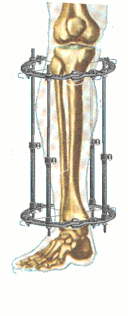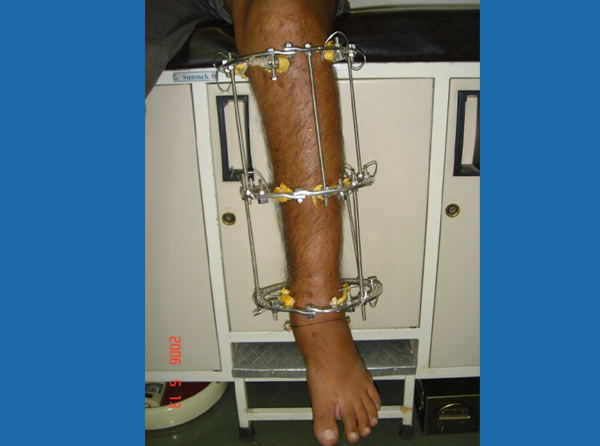
The Ilizarov frame was designed by Russian born Professor Gavrill Abramovich Ilizarov( 1921- 1992). In 1944 he was sent to Kurgan region to work in a country hospital, where he became chief of surgery in 1955. At the hospital Ilizarov was asked to review many soldiers with sequel of gunshot bone injuries which had been treated without success. His idea for the design came from observing wheels with spokes.He visualised the axis as the bone being held in place with spokes and supported with the wheel and so the idea of the Ilizarov frame was born. The original experiments were carried out on a broken stick a sculpture depicting this and Ilizarov are a symbol of today's Institute gracing both its grounds and entrance. Ilizarov's peers were very sceptical of his method and Professor Chinenkov stated " such a mechanical approach to surgery can not be considered useful." It was not until his successful treatment of Olympic high jump gold medal winner, Valery Brumel's infected non-union that Ilizarov's work and method gained fame. Ilizarov's device had many advantages over previous fixators. The high degree of fixation rigidity achieved by wire placement and tensioning providing optimum conditions for fracture stabilisation and healing.

The flexibility of wire positioning and use of olive wires allow for reduction of fractures by closed treatment. Stabilisation of the fracture without inhibiting movement or reducing function of joints and soft tissues. Ability to weight bear immediately after fixation These same advantages make it a popular choice today. Ilizarov carried out many experiments to evaluate bone-healing rates and proved it took spongy bone 8 days to unite in the optimal conditions created with the device. The use of the device expanded from transosseous compression to distraction osteosynthesis allowing us to perform bone lengthening and deformity correction today. Despite all of Ilizarov's work and research it was not until 1971 that he achieved true recognition when he established an Institute. There was an animal hospital with a capacity for 350 large animals on site. Here further clinical and experimental research could be carried out. The present Institute consists of 10 scientific departments, 12 clinical departments having 800 beds, and an animal clinic. There is also a manufacturing plant on site, which produces and sells Ilizarov fixators and other medical instruments.